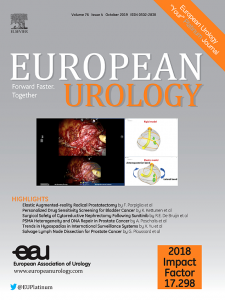膀胱癌剂量递增适应性放疗:RAIDER 2 期随机对照试验结果
IF 25.3
1区 医学
Q1 UROLOGY & NEPHROLOGY
引用次数: 0
摘要
背景和目的由于膀胱是一个可移动、可变形的结构,因此对其进行放疗具有挑战性。剂量递增的自适应图像引导放疗可改善疗效。RAIDER旨在证明这种计划的安全性。方法RAIDER是一项国际性二期非比较随机对照试验(ISRCTN26779187)。单灶T2-T4a尿路膀胱癌患者被随机(1:1:2)分配到标准全膀胱放疗(WBRT)、标准剂量自适应放疗(SART)或剂量递增自适应放疗(DART)。两种分次(f)计划独立招募。WBRT和SART剂量为55 Gy/20f或64 Gy/32f,DART剂量为60 Gy/20f或70 Gy/32f。对于 SART 和 DART,每天选择一种放疗方案(小型、中型或大型)。主要研究结果和局限性2015年10月至2020年4月期间,共有345名患者接受了随机治疗:20f/32f组别中分别有41/46名WBRT患者、41/46名SART患者和81/90名DART患者。中位年龄为72/73岁;78%/85%的患者患有T2肿瘤,46%/52%的患者接受了新辅助化疗,70%/71%的患者接受了放射增敏治疗。中位随访时间为42.1/38.2个月。计划接受DART治疗的77名20f参与者中有66名(86%)和82名32f参与者中有74名(90%)符合强制性中等计划剂量限制。在接受20f DART的58例患者中,有1例(90%置信区间[CI] 0.1,7.9)出现放疗相关的≥3级毒性;在接受32f DART的56例患者中,0例出现放疗相关的≥3级毒性。WBRT + SART 的两年总生存率为 77% (95% CI 69, 82),DART 为 80% (95% CI 73, 85)(危险比 = 0.84, 95% CI 0.59, 1.21, p = 0.4)。345名参与者中有13人(3.8%)进行了挽救性膀胱切除术。DART治疗安全可行,达到了预设的毒性阈值。剂量递增治疗的疾病相关结果令人乐观,挽救性膀胱切除率较低,总生存率与膀胱切除术队列中的结果相似。本文章由计算机程序翻译,如有差异,请以英文原文为准。
Dose-escalated Adaptive Radiotherapy for Bladder Cancer: Results of the Phase 2 RAIDER Randomised Controlled Trial
Background and objective
Delivering radiotherapy to the bladder is challenging as it is a mobile, deformable structure. Dose-escalated adaptive image-guided radiotherapy could improve outcomes. RAIDER aimed to demonstrate the safety of such a schedule.
Methods
RAIDER is an international phase 2 noncomparative randomised controlled trial (ISRCTN26779187). Patients with unifocal T2-T4a urothelial bladder cancer were randomised (1:1:2) to standard whole bladder radiotherapy (WBRT), standard-dose adaptive radiotherapy (SART), or dose-escalated adaptive radiotherapy (DART). Two fractionation (f) schedules recruited independently. WBRT and SART dose was 55 Gy/20f or 64 Gy/32f, and DART dose was 60 Gy/20f or 70 Gy/32f. For SART and DART, a radiotherapy plan (small, medium, or large) was chosen daily. The primary endpoint was the proportion of patients with radiotherapy-related late Common Terminology Criteria for Adverse Events grade ≥3 toxicity; the trial was designed to rule out >20% toxicity with DART.
Key findings and limitations
A total of 345 patients were randomised between October 2015 and April 2020: 41/46 WBRT, 41/46 SART, and 81/90 DART patients in the 20f/32f cohorts, respectively. The median age was 72/73 yr; 78%/85% had T2 tumours, 46%/52% had neoadjuvant chemotherapy, and 70%/71% had radiosensitising therapy. The median follow-up was 42.1/38.2 mo. Sixty-six of 77 (86%) 20f and 74 of 82 (90%) 32f participants planned for DART met the mandatory medium plan dose constraints. Radiotherapy-related grade ≥3 toxicity was reported in one of 58 patients (90% confidence interval [CI] 0.1, 7.9) with 20f DART and zero of 56 patients with 32f DART. Two-year overall survival was 77% (95% CI 69, 82) for WBRT + SART and 80% (95% CI 73, 85) for DART (hazard ratio = 0.84, 95% CI 0.59, 1.21, p = 0.4). Thirteen of 345 (3.8%) participants had salvage cystectomy.
Conclusions and clinical implications
Grade ≥3 late toxicity was low. DART was safe and feasible to deliver, meeting preset toxicity thresholds. Disease-related outcomes are promising for dose-escalated treatments, with a low salvage cystectomy rate and overall survival similar to that seen in cystectomy cohorts.
求助全文
通过发布文献求助,成功后即可免费获取论文全文。
去求助
来源期刊

European urology
医学-泌尿学与肾脏学
CiteScore
43.00
自引率
2.60%
发文量
1753
审稿时长
23 days
期刊介绍:
European Urology is a peer-reviewed journal that publishes original articles and reviews on a broad spectrum of urological issues. Covering topics such as oncology, impotence, infertility, pediatrics, lithiasis and endourology, the journal also highlights recent advances in techniques, instrumentation, surgery, and pediatric urology. This comprehensive approach provides readers with an in-depth guide to international developments in urology.
 求助内容:
求助内容: 应助结果提醒方式:
应助结果提醒方式:


